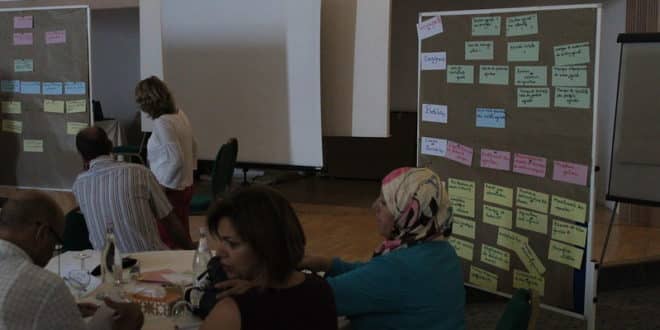In the field of international development, specific methods and approaches are used to plan a cooperation intervention. Many of them have been developed for the particular needs of donors. In this article, we briefly present the most widely used results-based approach: the logical framework approach.
This article is part of a series:
- The 4 phases of the project cycle
- What is the logical framework approach?
- What do you do during the identification phase of the project cycle?
- Most Significant Change: What it is and how to use it
- Results Indicators: What they are and how to use them
- Means of Verification: What it is and how to use it
Where is the “logic”?
The Logical Framework Approach (LFA) was first used in international development by USAID in 1969. Over the years, it has established itself as a standard in international cooperation circles. The LFA mainly consists of developing an intervention strategy based on the “cause-effect” or “means-ends” chain to link all elements of an intervention.

Generally, the elaboration of the results chain starts to be understood from its end, from the outcomes. The cause-effect relationship is justified in reverse: “to achieve this result, I need that activity”. We also have to take into account that we act in complex social systems. Therefore, assumptions and risks may play a role at each level. In LFA, their influence has to be analysed and some measures have to be taken to mitigate their possible consequences. Like other approaches, the LFA is not complete without well-defined measurable performance indicators and their sources of verification.
The Logical Framework Matrix
This methodology covers 3 areas:
1º. Analysis of the context of the intervention.
2º. The classification and structuring of the ideas.
3º. The presentation of the project in a clear and standardised way.
Sometimes projects have apparently been formulated under the Logical Framework methodology, but they have only applied this methodology for the presentation of the project, and not as a tool for analysing the context or for organising the ideas. This is a mistake that should be avoided.
The Logical Framework Matrix is usually a table composed of the following fields:
| Logic of the intervention | Objectively verifiable indicators | Verification sources | Assumptions | |
|
1. Overall objective
|
Objective to which the project is expected to make a significant contribution |
Not applicable* |
Not applicable* |
Not applicable* |
|
2. Specific Objective
|
The effect expected to be achieved as a result of the project. | Measures (direct and indirect) of achievement of the objective | Instrument for measurement of indicators | Events, conditions or decisions, outside the
control of the project, necessary to achieve the objective |
|
3. Result(s) They can be 1, 2, 3, 4 depending on each project.
|
Results that the project management must ensure | Measures (direct and indirect) of achievement of the result. | Events, conditions or decisions, outside the
control of the project, necessary to achieve the result(s) |
|
|
4. Activities
|
The activities that the project has to undertake to produce the results |
5. Resources Goods and services needed to carry out the project. |
6. Costs Cost of means |
The logic of the intervention
When writing a project, the first thing to do is to fill in the first column (logic of the intervention) from top to bottom.
- Overall objective: Describe in advance the long-term objective to which the project will contribute.
- Specific objective: Describes the expected effects of the project for the beneficiaries. It should be unique, and usually coincides with the title of the project.
- Results: These are expressed as objectives to be ensured by the project management during the life of the project.
- Activities: expressed as concrete interventions.
- Means: Material and non-material resources needed to carry out the activities.
- Costs: Money needed to obtain the means.
Need more help with logical frameworks?
External factors
Experience shows that it is not enough to carry out the activities to achieve the results, nor are the results sufficient to achieve the specific objective. Other conditions outside the direct control of the project, called external factors, must also be present. I fill in the last column of the matrix.
Indicators and sources of verification
Indicators are a way to measure the achievement of objectives and results. All objectives and results should have indicators, which can be quantitative or qualitative.
When defining indicators, it is also necessary to specify how they will be measured, which is known as the source of verification. If an indicator does not have a source of verification, it should be replaced by another that does. It should always be borne in mind that data collection should not be excessively costly compared to the benefit it brings. If the collection process is impractical, another indicator should be chosen.





